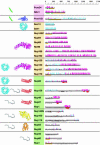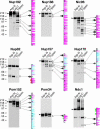Simple fold composition and modular architecture of the nuclear pore complex
- PMID: 16461911
- PMCID: PMC1413685
- DOI: 10.1073/pnas.0506345103
Simple fold composition and modular architecture of the nuclear pore complex
Abstract
The nuclear pore complex (NPC) consists of multiple copies of approximately 30 different proteins [nucleoporins (nups)], forming a channel in the nuclear envelope that mediates macromolecular transport between the cytosol and the nucleus. With <5% of the nup residues currently available in experimentally determined structures, little is known about the detailed structure of the NPC. Here, we use a combined computational and biochemical approach to assign folds for approximately 95% of the residues in the yeast and vertebrate nups. These fold assignments suggest an underlying simplicity in the composition and modularity in the architecture of all eukaryotic NPCs. The simplicity in NPC composition is reflected in the presence of only eight fold types, with the three most frequent folds accounting for approximately 85% of the residues. The modularity in NPC architecture is reflected in its hierarchical and symmetrical organization that partitions the predicted nup folds into three groups: the transmembrane group containing transmembrane helices and a cadherin fold, the central scaffold group containing beta-propeller and alpha-solenoid folds, and the peripheral FG group containing predominantly the FG repeats and the coiled-coil fold. Moreover, similarities between structures in coated vesicles and those in the NPC support our prior hypothesis for their common evolutionary origin in a progenitor protocoatomer. The small number of predicted fold types in the NPC and their internal symmetries suggest that the bulk of the NPC structure has evolved through extensive motif and gene duplication from a simple precursor set of only a few proteins.
Conflict of interest statement
Conflict of interest statement: No conflicts declared.
Figures



References
Publication types
MeSH terms
Substances
Grants and funding
- GM62529/GM/NIGMS NIH HHS/United States
- R33 CA089810/CA/NCI NIH HHS/United States
- RR022220/RR/NCRR NIH HHS/United States
- P41 RR000862/RR/NCRR NIH HHS/United States
- U54 RR022220/RR/NCRR NIH HHS/United States
- CA89810/CA/NCI NIH HHS/United States
- P50 GM062529/GM/NIGMS NIH HHS/United States
- R01 GM054762/GM/NIGMS NIH HHS/United States
- R29 GM054762/GM/NIGMS NIH HHS/United States
- GM54762/GM/NIGMS NIH HHS/United States
- GM062427/GM/NIGMS NIH HHS/United States
- RR00862/RR/NCRR NIH HHS/United States
- R01 GM062427/GM/NIGMS NIH HHS/United States
LinkOut - more resources
Full Text Sources
Other Literature Sources
Molecular Biology Databases

